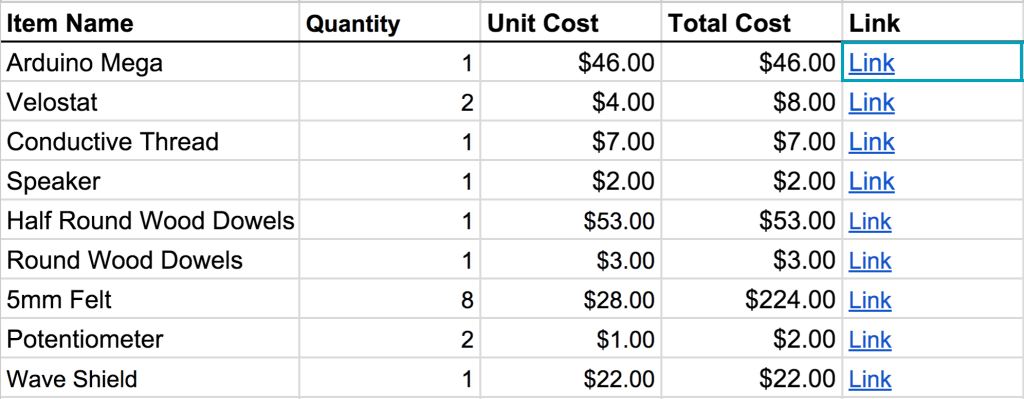This past week did user testing on our prototype, and updated things like the bill of materials and the timeline for the project. We also had a wonderful meeting with Anita Perr, PhD and Clinical Associate Professor, and Kristie Koenig, Chair of the Department of Occupational Therapy at NYU.
User Testing
On Monday we had the chance to do some user testing is class, which was a great opportunity to see how people reacted to our project in real time. We tried to allow as much free exploration as possible with giving instructions, and observe the engagement from the outside without interfering. After the user played with our prototype, we asked a few questions:
- Does the interaction seem engaging?
- Are the colors exciting?
- Do you know how to interact with the Silophon? Do you need guidance?
- How does the fabrication feel?
- What do think about the slight angle?
- What do you think about the size? Good / bigger / smaller?
- Does it seem durable for children?
Here are some answers we got:
- The interaction is very engaging, people just seem to want to play with it.
- Colors, good and fun
- Most people know what the interaction is (from previous use)
- Fabrication seem to be getting a good response, especially from the professionals.
- The angle is good and necessary
- Most people seem to say that the three notes we made as a prototype should be the middle of the Silophon.
- It’s not durable enough for children yet. Needs to be more sturdy and especially pay attention to the mallet! Also, make more than one mallet.
Meeting with Professionals
Meeting Kristie and Anita was great. We showed them our progress thus far, and they we very excited about the project. They both immediately expressed desire to interact with the Silophon and had a lot of insights to share with us about one of our key target audiences, children with Autism.
They assured us that indeed many people with Autism are hyper-sensitive to sounds and that they engage well with music. However, higher pitch sounds in particular are especially unpleasing for this group, but perhaps by being able to control these sounds, children with Autism could find sounds to be a point for engagement and not neglection.
We were also encouraged to visit this blog by Paul Kotler, who has autism himself.
Paul shares his personal experience and interaction with the world as an individual with autism. Here’s an excerpt of one of his posts describing the sound of rain:
“Rain means different sounds. Sounds out of the ordinary of daily and sounds that are utterly fascinating. I have heard people say that no two snowflakes are the same. Well, I can also say that no two rain storms are the same. They each have distinctive sound. It is like a symphony and it is delightful. Rain falling on a flat roof sounds different than rain falling on an angled roof. Rain hitting windows of different thickness makes different tones. I can almost hear the glass ringing with the sound. The way the wind blows absolutely changes the music of the rain. Overall, it is a wonderful sound that I wish I could share with others.”
Kristie mentioned that we might also want to consider:
- A visual model / visual feedback that might go along with the Silophon. An idea for visual feedback could be incorporated with color coded music notes that would teach how to play songs → Guitar Hero model.
- A headset connection
- A different form for the dowel of the mallet. It seems that it needs to be more sturdy and easy to grip.
- Knobs for controllers
One of the most important things we learned from this meeting were the key elements to successful design for autism:
Two other resources Kristie pointed us to:
Karla’s ASD Page
The Thinking People’s Guide to Autism
System Diagram
Ideas we had for wiring/electronics:
Use a resistor ladder as an DAC to output nice sounds (thanks to this guy’s videos)
Possibly using a different processor. Tested ATTiny84, a ATMega32, and an Arduino Mega
Lessons we learned // Fabrication
Covering an entire piece for material with felt will not look good (as we tried on our prototype). Instead, we we have a thick wooden piece be the note and a layer of industrial felt over that piece of wood. The sensor will go in between.




